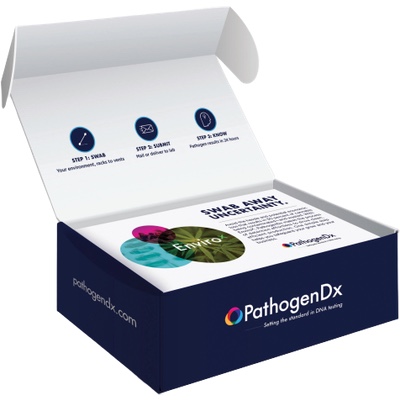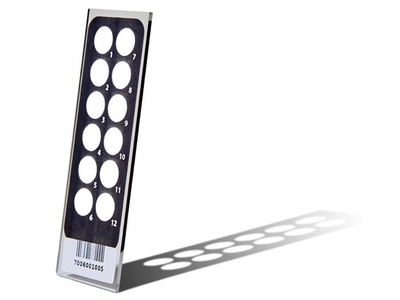Founded in 2014 by a group of ambitious business experts, PathogenDx is a US-based microarray testing solution provider that provides a product that can rapidly identify bacterial, fungal, and viral threats.
The captain of this ship is CEO and co-founder Milan Patel. "I am responsible for managing our overall strategy and operations,” he says. This includes ensuring that the leadership team and organisation is executing the company’s strategic vision, delegating and directing agendas, driving profitability, managing company organisational structure, and communicating with the board.
Trained as an electrical engineer and then completing a biomedical/medical engineering master’s, Patel then acknowledged the need for a better understanding of business to achieve his dreams. “Even after completing two technical degrees, I knew that obtaining knowledge and understanding the ins and outs of business would provide a strong foundation for my path going forward, so that was my primary reason for pursuing an additional master’s in business,” he says.
Our primary competition lies in the major qPCR in vitro diagnostics and life science companies
Patel says that “business management runs on dollars and cents”, the understanding of which calls for its own unique skill set. He goes on to explain that growing a successful organisation goes beyond the good technical design of a product. It is also about defining a practical strategy and vision.
For a man with a medical engineering and business background, it seems like a 180 to found a microbiological testing company. Talking about his introduction to the controlled environment sector, Patel explains that it came from cannabis testing labs. “With these labs processing hundreds of samples a day, it didn’t take too long to understand and know the relationship between workflow separation, clean aseptic techniques, and the need to environmentally swab samples to identify contamination – and how that could impact the quality control aspect of running a microbial test in the lab,” he says.
Building from the ground up
So armed with a background in medical topics and an understanding of business, Patel moved through a series of managerial roles. He spent time at companies like Intel, Acentia, Collabralink Technologies, and GMSBiotech.
It was at some point in this journey that the unique technology that was the basis of PathogenDx began its journey. “Prior to founding PathogenDx, we knew we had a unique technology. Something that was ahead of its time at that point and had the potential to not only innovate the pathogen testing sector, but deliver vital solutions to save both money and lives,” Patel recalls. “Furthermore, the federal government had funded our technology through grants.”
Then finally in 2014, the founding group established PathogenDx with a defining product that allows test labs to conduct between 12- 48 tests in parallel, testing up to 20 pathogens per test in less than a days’ shift. This is done at a fraction of the cost of plate counts or RT-PCR, and also uses a raw sample technology that allows labs to bypass almost 20 steps required by RT-PCR. Saving time and money.

The first three years were a hard grind getting the platform commercially running. But steadily, every milestone was passed. FDA/EUA approval of the company’s first clinical assay, the first commercial revenue dollar, and then hitting 100 customers.
“My motivation to co-found PathogenDx was to ensure that this technology saw the light of day, meaning that it would be commercialised - and that’s precisely what we did,” Patel says.
Patel is well aware of the company’s competition in the microbiological testing sector. "Our primary competition lies in the major qPCR Invitro diagnostics and life science companies,” he says. “We differentiate ourselves based on the unique ability to multiplex test multiple targets all in the same sample, at a fraction of the time, cost, and labour compared to conventional molecular platforms.”
He adds that the company may share similar goals with other diagnostic companies, but the efficiency and sustainability of its methods are its key defining feature. A proud statistic of Patel’s being that the company’s technology creates 65% less plastic waste than qPCR or plate culture per test.
Burning questions
In the years that Patel has been championing PathogenDx’s microarray technology (pictured below), he has developed a great understanding of the specifics of molecular testing. A subject that he seems keen to dive into.
“The technology we create and utilise remains unique among microarray providers in that it is super low cost, with a high dynamic range that allows us to not only drill down from testing at the analyte level to single nucleotide polymorphism, but test at high volume,” he says. “The platform is also sample agnostic and temperature agnostic, eliminating the need for heating and cooling cycles.”
A major point of discussion that comes up is the comparison between endpoint PCR and qPCR. He points out the sensitivity benefits of endpoint PCR, and explains that this is simply because the amplification of the analyte DNA is taken to the end-point in terms of full utilisation of the primer.
Another industry sticking point is looking at living vs dead microbes. In 2021, the company launched a test that separates live cells from dead cells for cannabis bacterial or fungal safety tests. Patel explains that PCR and DNA-based methods have been criticised for detecting dead cells. “Hence the need for separation,” he says.
Patel also emphasises the importance of a living vs dead test as “there is always some form of remediation and sterilisation before the sample is sent into the lab”.

“[The test] works through a two-step centrifugation process, whereby there is a slow-spin step followed by a secondary fast-spin step, whereby free floating DNA from dead cells float to the top (ie supernatant) and live cells form a small pellet at the bottom,” Patel explains. “The supernatant material is then discarded and only the pellet is then processed as part of the test.”
Identifying this test as filling a need in the industry, Patel says that the company patented a biochemical enyzmatic assay, where if there are any residual dead cells, the addition of the enzyme will remove the remaining residual dead cells. Assuring that only live cells are being processed as part of the test, addressing a key issue in the industry.
Sample conditions and issues with viable colonies are two topics that Patel emphasises as one of the issues with the traditional plate count method. “Plate cultures benefit bacterial organisms and is more challenging for fungal organisms, so very specific time, temperature and enrichment media is required.”
With fungal contamination being a specific concern with cannabis production, this is a major issue in the industry.
"Not all labs want to take samples and process through two separate workflows, so they use a universal enrichment media which then compromises the very intent of looking for that fungal organism,” he says. "Also, not all organisms can be cultured; there are categories of viable but nonculturable and/or damaged cells that will not be able to culture. Hence the need for using a molecular platform like ours, which does triplicate testing per analyte and ensures specificity of the actual organism detected in the sample.”
Keeping cannabis clean
The regulatory landscape for cannabis is barely understood by even those most entrenched in the industry. The only consensus worldwide is that there is indeed increasing regulation, even if enforcement and consistency are limited.
“Differing international regulations of the cannabis market are certainly a hurdle, and those at the forefront of each different area should be doing all they can to strive for alignment,” Patel enthuses. “At the microbial or pathogen level, there will need to be harmonisation at the AOAC level with AFNOR [Association French Normalization Organization Regulation]. Clarity in all aspects of the industry will be much more attainable once international regulations reach a more uniform and reasonable place.”
Testing for pathogens under a regulated structure occurs even if it’s not federalised
For this exact reason however, many find it is best to be prepared for anything. Patel explains that rapid pathogen detection is already being used within cannabis processing in the US. “Testing for pathogens under a regulated structure occurs even if it’s not federalised. Every state that is legalised for medical or adult-use cannabis markets has a regulatory framework for microbial testing comprising of pathogen and class indicator organisms.”
Regulatory inconsistency is one of the things that Patel has striven to address with the company platform. “Some states call for regulated testing of Salmonella, E. Coli Stec 1 and 2, Aspergillus Flavus, Aspergillus Fumigatus, Aspergillus Niger and Aspergillus Terreu; while other states call for Staph Aureus, Clostridium Botulism and Listeria Monocytogenes. With all these pathogens already in the mix, our platform is already positioned for multiplexing.”
At the end of the day, Patel stresses that an entrance to the cannabis sector is not for the faint of heart. “You need to realistically understand the money you will need and the time it takes for approvals and certifications to come through,” he says.
A future in pharma
Patel explains that the company spans many different sectors, with a hugely horizontal product.
As such he likes to work with companies to help them actually address their problems. “We had a particularly interesting case working with a client that had significant airborne contamination in their grows,” he recalls. “In response, we brought in an air collector to help them identify sources of airborne and surface contamination to help mitigate an outbreak. We then proposed a sanitation protocol and a regular preventative environmental monitoring cycle. Our effort resulted in the lowest failures for regulated compliance samples the grower had seen in three years since starting operations.”
We had a particularly interesting case working with a client that had significant airborne contamination in their grows
Though cannabis has been their main sector, this is just the launching pad. The company has its eyes on the pharmaceutical sector. “There is certainly room for [the pharma sector] in that our technological solution avoids the need for enrichment for micro testing, which could save time to get results and ultimately reduce cost,” Patel says.
Microbial testing required by the pharmaceutical industry is based on the Pharmacopeia standard that mandates enrichment. Patel explains that moving to an AOAC or FDA standard will allow PathogenDx to potentially penetrate the pharmaceutical market. “[This] remains among our goals!” Adjacent to the pharmaceutical industry, Patel is also looking to improve the company’s presence in human and clinical diagnostics. “I am eager to get more into the Multiplex testing of Infectious Disease Syndromic Panels segment of diagnostics. So much of our work at PathogenDx is driven by expediting the diagnostic process to the benefit of patients and budgets alike, so the methods of consolidation and efficiency offered by Multiplex PCR tests are a natural target for us at PathogenDx.”
The CEO explains that this was definitely emphasised by two years in a pandemic and all the variant testing capabilities that the company was able to offer in this time.
With a technology that is more efficient and cheaper than Next Generation Sequencing (NGS), this pivoted the company into clinical/human diagnostics and other life-saving applications.
